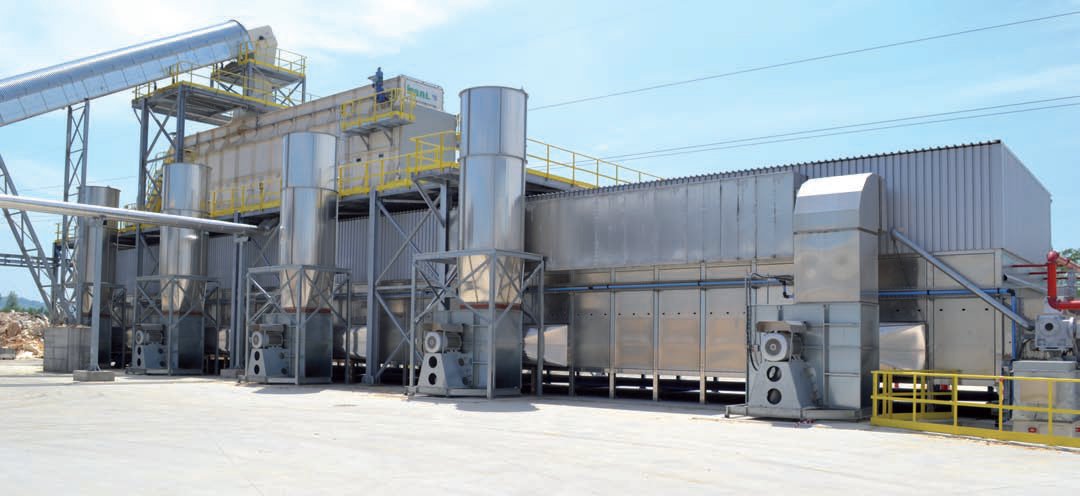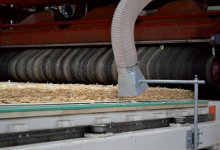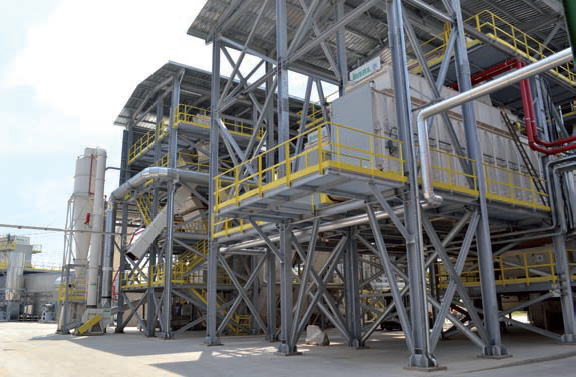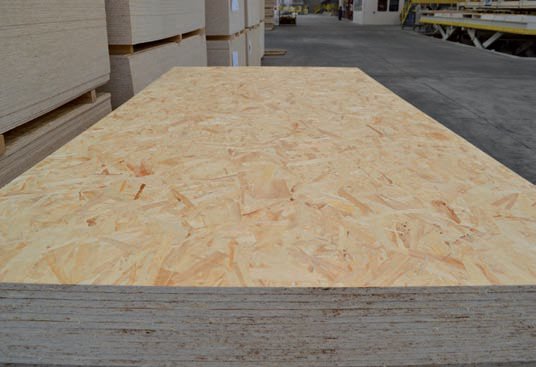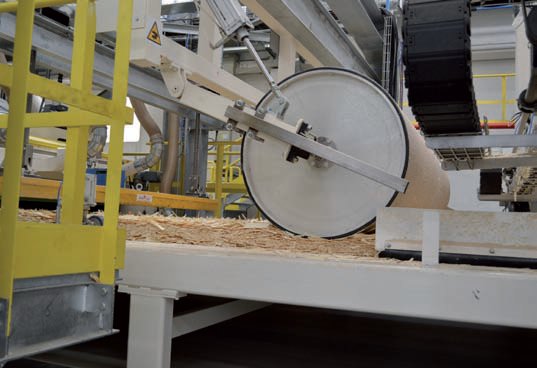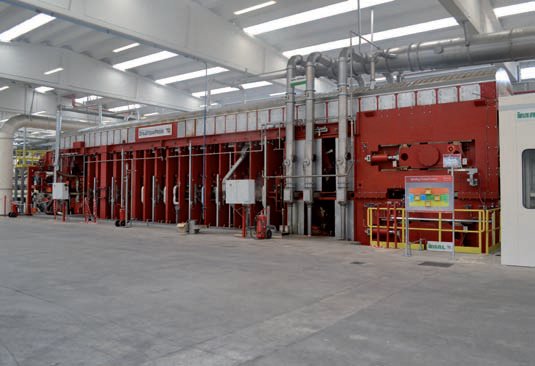Two ‘firsts’ at I-PAN
25 September 2013As the latest complete panel production line supplier, IMAL-PAL srl has supplied the first continuous line to a panel manufacturer to make OSB in Italy. Mike Botting visited the ‘I-PAN’ factory in Piedmont.
For many years, the market for continuous presses was controlled by three German companies: Siempelkamp, Dieffenbacher and Küsters (latterly Metso Panelboard), with the Küsterstype press having been absorbed by Siempelkamp in 2007.
There have been a few Chinese manufacturers offering continuous presses in more recent years, but now there is a new European company in the market.
Now IMAL-PAL srl of Italy is able to offer a continuous press to its own design, assembled in its own factory in Italy, and now the group has its first continuous panel line running in Europe. That line produces OSB panels, made 100% from plantation-grown poplar.
The customer's parent company is Bonzano Industries and the customer - a company set up for the OSB project - is I-PAN.
However, it is not just the press which the IMAL-PAL group has supplied to this project. The supply and installation of the complete production line, from log yard to finished panel, came under IMAL-PAL's direct control and most of it was designed and manufactured by that company and supplied as a turnkey project.
Only items requiring specific experience and expertise, such as the stranders, energy plant and dryer were made entirely by others, but still, in many cases, with input from IMALPAL on the engineering specifications.
Bonzano Industries
Bonzano Industries was founded in 1950, producing its first wood based panels in 1952, using poplar as the raw material.
In 1966, Bonzano founded IBL as a producer of poplar plywood, blockboard and veneered panels.
In 1972 the company produced the first thin particleboard in Italy, on a Mende-type continuous calender press, following that with the first thin MDF in the world in 1982.
In 1998, IBL acquired Hungarian poplar plywood maker Derula, using plantation-grown poplar from the Szolnok area of Hungary.
In 2012, in a completely new departure for the group - and a first for both Italy and Europe - IBL then set up I-PAN to produce OSB 100% from poplar, sourcing around 80% of the logs from plantations in the Piedmont and Monferrato area of Italy.
The IMAL-PAL line
The debarking line, including the log infeed system and the debarker itself, was designed and built by Pal of Ponte di Piave - one half of the IMAL-PAL Group.
After debarking, the logs pass to the disc strander. This is a 48-knife, 25 tonne per hour (tph) machine built by Carmanah of Canada - a company with a long history in OSB strand preparation. Strands are 100mm long, with thicknesses between 0.4 and 0.7mm.
A separate control room has CCTV and computer monitor screens to control the whole debarking and stranding process and associated log movements.
The wet strands are conveyed from the strander up to the wet strand bunker above the dryer.
Here is the first item of machinery which you will not find in any other OSB factory in the world, as the concept was conceived by IMAL-PAL specifically for this project.
Rather than a conventional drum dryer, running at high temperature, 'I-PAN' has a belt dryer.
To understand the operating principle of this dryer, we first have to look at the energy plant. This is a combined heat and electrical energy generator using 100% wood waste. The energy plant produces thermal oil for the continuous press and also steam to power a turbine which generates one MW of electricity.
The air in the dryer is heated by hot water from the turbine, which means, said Loris Zanasi, managing director and ceo of Imal, the dryer's heat is effectively almost free of charge.
IMAL-PAL also claims that the thin, long strands produced by the Carmanah strander are not subjected to the physical damage which can occur in a conventional drum dryer, while the lower dryer temperature avoids heat damage to the strands.
The strands enter the dryer at around 120% moisture content, exit at 1.5 to 2.0%, and are transported on a covered conveyor up to the screening tower, where Pal screens remove oversize and fine material.
The unique Imal gluing system, in which the resin is sprayed onto the strands, follows the screening process. The resin used is MDI, with a release agent applied to the press belts.
Up to this point, all the equipment is housed in roofed, steel-lattice framed, buildings outside the main production hall.
'I-PAN' used an existing, refurbished, concrete-framed building for that production hall. This building had a lower-than-normal roof height for a panel production line, but IMAL-PAL designed the line to fit within that envelope. This meant that the formers had to have a lower height than is common for such lines and saved the cost of raising the roof of the building, as apparently suggested by others quoting to supply the line.
The three-head forming system was designed and made by Pal and aligns the strands longitudinally in the top and bottom surface layers and transversely in the core.
The mattress then passes through an important feature of this press line - the Dynasteam belt press. Steam is injected into both top and bottom surfaces of the mat to reduce pressing time in the hot press.
A compressing roller then removes some air from the mat before it is edge-trimmed by two large circular saws and enters the prepress, which is itself followed by the Imal Xray weight-per-unit-area gauge and the Cassel metal detector.
The 'beating heart' of the line, the Dynasteam Continuous Press, is 15m long and 2.65m wide and is protected by a Minifog PressProtect spark detection/extinguishing system.
The board leaving the press is cut to length by a flying diagonal cross-cut saw housed in its own chamber. This saw was also developed by IMAL-PAL.
After the cross-cut comes the Imal FBC100 blister/delamination detector. This, said Mr Zanasi, is unique in measuring the entire area of the panel, rather than at several points across the width. Those conventional systems only measure about 30% of the panel's width, he suggested. A thickness gauge follows the FBC100.
The cooling star was supplied by another Italian company, EMG, as part of the IMALPAL contract.
The complete production line is controlled from a sophisticated control room and all control software for the line was designed and supplied by Imal.
Installation of the machinery on the Coniolo site for the first-ever European poplar OSB line began in April 2012. The first board was produced on December 20 of that year and commercial production began at the end of January 2013. Design capacity of the line is 160,000m3/year.
Why OSB?
Plywood is still made, and blockboard traded, on the Coniolo site, although the thin particleboard and MDF lines are now closed.
The company realised that there was no existing producer of OSB in Italy and, since the Bonzano Group already had markets for its plywood, OSB seemed a natural progression for the company.
Because the wood raw material is poplar, I-PAN's board is very light in colour, and light in weight at around 500kg/m3, with no visible gaps between the strands, making it a unique proposition in the European OSB market.
IMAL-PAL and 'I-PAN' have combined to 'break the mould' in OSB production and to produce the first OSB in Italy.
